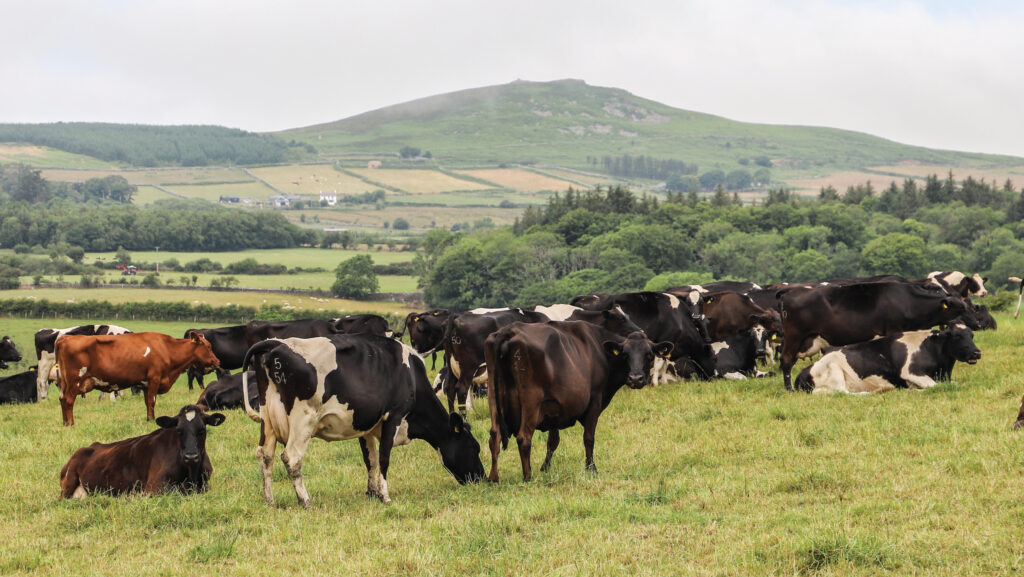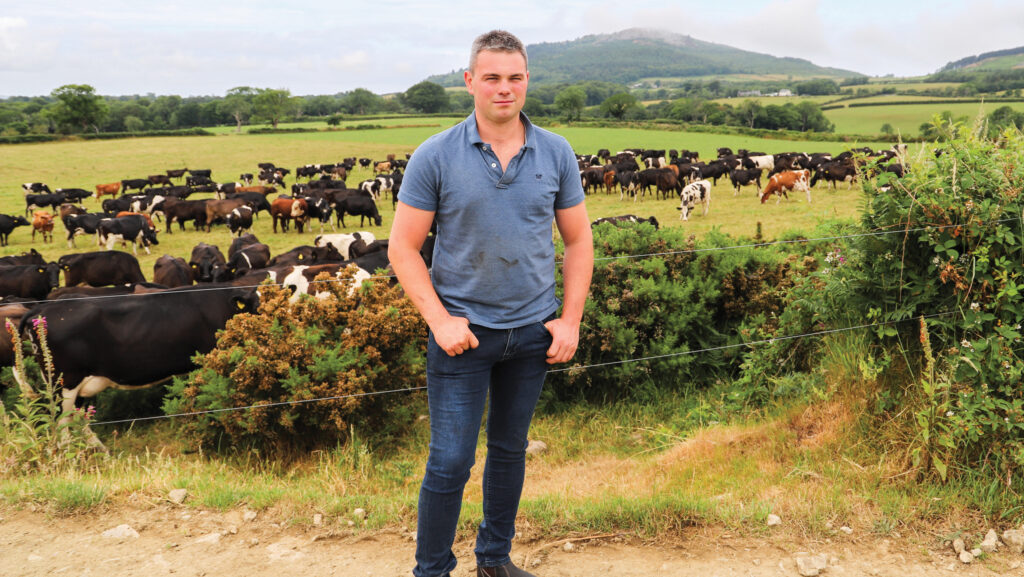How milking protocol reset helped mastitis management
 © Farming Connect
© Farming Connect When mastitis levels peaked at 25 cases in every 100 cows and somatic cell count spiked in the second half of the lactation, Ifan Ifans knew action was needed.
Ifan and his father, Tomos, produce milk from autumn-calving cows at Tyddyn Cae near Pwllheli, a herd they established five years ago after converting the farm from beef and sheep to dairy.
Ifan joined the family business in 2018 after studying at Harper Adams University and the decision was made at that time to switch to dairying.
See also: What are the most common causes of mastitis in UK herds?
Farm facts
Tyddyn Cae, near Pwllheli, Lleyn Peninsula
- 240ha farmed – 100ha owned and 140ha rented
- One full-time employee and relief milkers
- 12-week calving block
- 6,800 litres annual average milk yield, 560kg solids
- 4.4% butterfat and 3.6% protein
- Average cow bodyweight 525kg
- Conventional semen used at breeding followed by Hereford sweeper bulls
- Beef calves reared to 18 months and sold as stores
The beef and sheep infrastructure had become dated, so it was a case of either investing in that or in milk production.
“We didn’t have the confidence to invest in beef and sheep and saw it as a good time to convert to a different system,” says Ifan.
“Dad had farmed here since he was 16 and felt that he had had his time, and the time was right to convert.”
A new setup was established on a greenfield site, featuring a 20/40 Fullwood semi-rapid exit parlour with automatic cluster flush and associated infrastructure.
The farm was stocked with New Zealand and Irish Friesians – initially 200 cows, but now calving 400 this autumn.
A milk contract for autumn supply was secured with South Caernarfon Creameries. “I believe in supplying what the market wants, and at that time – and it is still the case – the demand is for autumn milk,” says Ifan.

Ifan Ifans © Farming Connect
Grazed grass is an important part of the system, with the herd grazing from the start of February to the beginning of November.
Cows are fed a total mixed ration (TMR) that includes home-grown maize, wholecrop and multicut silage.
One of the weaknesses Ifan was keen to improve was udder health.
Mastitis levels were high and when somatic cell count (SCC) increased in the second half of the lactation, when cows were housed.
This meant that in some months the business failed to achieve the top band for milk price premiums.
As one of 15 farms in the Farming Connect Our Farms network, Tyddyn Cae was supported to introduce a number of key changes under the guidance of Tom Greenham, of Advance Milking.
To assess what needed to be done, static and dynamic milking machine tests were carried out, udder health assessed, and an environmental analysis and labour efficiency study undertaken.
The machine tests showed that the plant was performing well, so the focus shifted to other areas.
Based on the findings, Tom suggested new protocols in collaboration with Ifan and his staff, and several changes have now been introduced.
Adjustments to milking parlour routine
Previously at milking, the teats of all 20 cows in the row were wiped. The clusters were then attached, starting with the cow that was last to be cleaned and working back to the first in the row.
However, the time lag between first stimulation and the unit being attached was too variable, which affected milk let-down.
On Tom’s advice, the two people in the parlour now take charge of 10 cows, with the row split in two. Each milker cleans 10 cows and then attaches the clusters, starting with the one cleaned first.
Staff also embarked on a refresher course in good milking routine practices.
Increasing frequency of milk recording
Milk recording had been sporadic, but is now carried out six times a year to monitor mastitis to catch infections at an early stage. Picking mastitis up earlier makes it less likely that infection becomes chronic.
Recording provides SCC readings for individual cows – a threshold of 200,000 cells/ml is generally accepted as an indicator of mastitis incidence.
Cell counts at Tyddyn Cae now average 168,000 cells/ml, comfortably within the milk buyer’s 225,000 cells/ml threshold.
Greater use of selective dry cow therapy
There had been blanket use of antibiotics across all cows to treat and prevent new infections developing during the dry period. Now, antibiotics are targeted at cows that are likely to be infected.
Using SCC data from milk recordings allows Ifan to select cows at high risk of mastitis at drying off. Teat sealants only are used on cows that are not in that risk category.
Increasing frequency of scraping during housing
Mastitis-causing micro-organisms can be transmitted from dirty floors and passageways and lying areas.
The cubicle housing at Tyddyn Cae has an automated slurry scraper system that had been timed to travel up and down passageways every three hours.
To avoid build-up of slurry and cows carrying it on their feet into the cubicle beds, the interval between scrapings has been reduced to an hour.
“The beds stay cleaner so there is less muck on their udders,” says Ifan.
Increasing scraping frequency is also a very useful addition to the farm’s lameness strategy.
New software for herd monitoring
Investment has been made in new software for monitoring the herd. Data are collected from the parlour’s feed-to-yield software and transferred to Uniform Agri, where milk recording data can also be incorporated.
Ifan says the next step is to add a heat monitoring system that integrates with Uniform Agri.
Outcome
Although it is too early to establish how the changes have affected mastitis levels, Ifan is confident that the improvements will pay off.
“I and the team benefited greatly from having Tom on the farm to look over our dairy system and to chat with us all,” he says.
“Having external eyes in to look at your system is very beneficial, because they may offer new ideas and recommendations for small changes in our milking routine to speed up the system and improve cow welfare.”
Our Farms events for September
Tyddyn Cae and all the farms in the Farming Connect Our Farms network are hosting events throughout September to share the latest results from the project and trials they have been involved with.
Our Farms farmers are involved in a diverse range of projects that assess the effects of introducing different practices, from feeding crimped peas and beans to pregnant ewes, to optimising seasonal calving for sustainable herd expansion, health and efficiency.
The full list of the events is at businesswales.gov.wales/farmingconnect/whats-on
